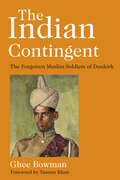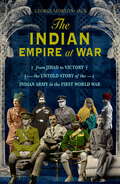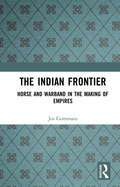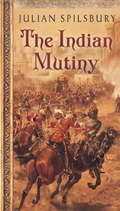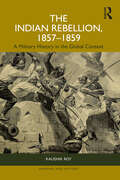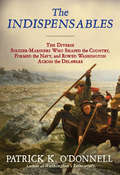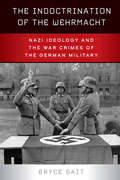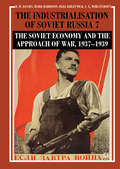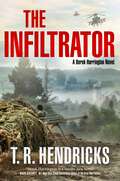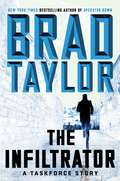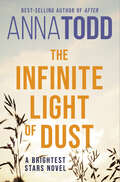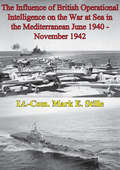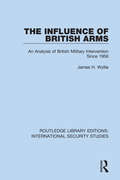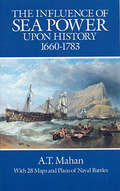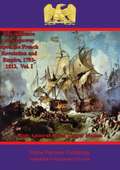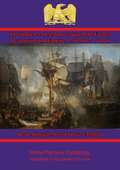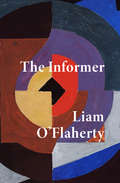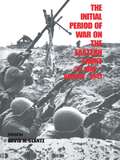- Table View
- List View
The Indian Contingent: The Forgotten Muslim Soldiers of Dunkirk
by Ghee Bowman‘An incredible and important story, finally being told’ Mishal Husain‘Groundbreaking ... a riveting and moving account’ Yasmin KhanOn 28 May 1940, Major Akbar Khan marched at the head of 299 soldiers along a beach in northern France. They were the only Indians in the British Expeditionary Force at Dunkirk. With Stuka sirens wailing, shells falling in the water and Tommies lining up to be evacuated, these soldiers of the British Indian Army, carrying their disabled imam, found their way to the East Mole and embarked for England in the dead of night. On reaching Dover, they borrowed brass trays and started playing Punjabi folk music, upon which even ‘many British spectators joined in the dance’. What journey had brought these men to Europe? What became of them – and of comrades captured by the Germans? With the engaging style of a true storyteller, Ghee Bowman reveals in full, for the first time, the astonishing story of the Indian Contingent, from their arrival in France on 26 December 1939 to their return to an India on the verge of partition. It is one of the war’s hidden stories that casts fresh light on Britain and its empire.
The Indian Corps In France [Illustrated Edition]
by Lt.-Col. John Walter Beresford Merewether Frederick Edwin Smith Earl of BirkenheadIncludes 24 portraits, maps and plans."The only history of the Indian Corps in France in the Great War, from 1914 to 1915 when the Corps transferred to the Middle East. A fascinating story.The Indian Corps, consisting of two infantry divisions (Meerut and Lahore), arrived in France in September/October 1914. It was commanded by Lieutenant-General Sir James Willcocks who was the most senior officer in the BEF after Field Marshal Sir John French and General Sir Horace Smith-Dorrien. The corps remained on the Western Front till the end of 1915, when it was transferred to the Middle East, a more suitable theatre of war for Indian Army troops. This history was published at the request and under the authority of the India Office, and apart from General Willcocks' own memoirs, With The Indians in France, it is the only record of the corps. It is not altogether a happy tale, as the book makes clear. While there was no questioning the bravery of the troops (five Indian/Gurkha VCs) there were problems of climate, reinforcements, officer casualties (the Indian battalion had only 13 British officers, who were first priority targets for the Germans), not to mention mishandling and lack of understanding on the part of the High Command. Total casualties among Indian Army units amounted to 21,413 (each division had, initially, three British battalions and divisional artillery was British). An unusual and fascinating story and history."-Print Ed.
The Indian Empire At War: From Jihad to Victory, The Untold Story of the Indian Army in the First World War
by George Morton-Jack'Essential to a proper understanding of the war and of our world of today' Michael Morpurgo1.5 million Indians fought with the British in the First World War - from Flanders to the African bush and the deserts of the Islamic world, they saved the Allies from defeat in 1914 and were vital to global victory in 1918. Using previously unpublished veteran interviews, this is their story, told as never before.
The Indian Frontier: Horse and Warband in the Making of Empires
by Jos GommansThis omnibus brings together some old and some recent works by Jos Gommans on the warhorse and its impact on medieval and early modern state-formation in South Asia. These studies are based on Gommans’ observation that Indian empires always had to deal with a highly dynamic inner frontier between semi-arid wilderness and settled agriculture. Such inner frontiers could only be bridged by the ongoing movements of Turkish, Afghan, Rajput and other warbands. Like the most spectacular examples of the Delhi Sultanate and the Mughal Empires, they all based their power on the exploitation of the most lethal weapon of that time: the warhorse. In discussing the breeding and trading of horses and their role in medieval and early modern South Asian warfare, Gommans also makes some thought-provoking comparisons with Europe and the Middle East. Since the Indian frontier is part of the much larger Eurasian Arid Zone that links the Indian subcontinent to West, Central and East Asia, the final essay explores the connected and entangled history of the Turko-Mongolian warband in the Ottoman and Timurid Empires, Russia and China.
The Indian Mutiny
by Julian SpilsburyAn epic true story of treachery, revenge and courageThe Indian Mutiny is a real page-turner, an epic story with surprising modern parallels. Fomer army officer-turned-TV scriptwriter, Julian Spilsbury is the ideal author to take us back to the desperate summer of 1857 when thousands of Indian soldiers mutinied. They murdered their officers, hunted down the women and children and burned and slaughtered their way to Delhi. The tiny British garrison at Lucknow held out against all odds; the one at Cawnpore surrendered only to be betrayed and massacred.Modern Indian accounts call this 'the first war of liberation', but as Julian Spilsbury reveals, 80 per cent of the so-called 'British' forces were from the sub-continent. Sikhs, Gurkhas and Afghans fought alongside small numbers of British soldiers. Together, they faced terrible odds and won. In the process they created a new army that would play a vital role in the Allied forces in both World Wars. Julian Spilsbury weaves the story together from some of the most vivid eyewitness accounts ever written. From the women and children hiding from blood-crazed mobs, to the epic battles that decided the campaign, to the grisly revenge exacted by the British forces, this is a gripping recreation of the greatest crisis of Empire.
The Indian Mutiny
by Julian SpilsburyAn epic true story of treachery, revenge and courageThe Indian Mutiny is a real page-turner, an epic story with surprising modern parallels. Fomer army officer-turned-TV scriptwriter, Julian Spilsbury is the ideal author to take us back to the desperate summer of 1857 when thousands of Indian soldiers mutinied. They murdered their officers, hunted down the women and children and burned and slaughtered their way to Delhi. The tiny British garrison at Lucknow held out against all odds; the one at Cawnpore surrendered only to be betrayed and massacred.Modern Indian accounts call this 'the first war of liberation', but as Julian Spilsbury reveals, 80 per cent of the so-called 'British' forces were from the sub-continent. Sikhs, Gurkhas and Afghans fought alongside small numbers of British soldiers. Together, they faced terrible odds and won. In the process they created a new army that would play a vital role in the Allied forces in both World Wars. Julian Spilsbury weaves the story together from some of the most vivid eyewitness accounts ever written. From the women and children hiding from blood-crazed mobs, to the epic battles that decided the campaign, to the grisly revenge exacted by the British forces, this is a gripping recreation of the greatest crisis of Empire.
The Indian Rebellion, 1857-1859: A Military History in the Global Context (Warfare and History)
by Kaushik RoyThe Indian Rebellion 1857–1859: A Military History in the Global Context focuses on the military dimension of this conflict, in which Indian rebels waged both conventional and unconventional warfare against the British.In the summer of 1857, British rule almost disintegrated in north India due to the rebellion of the Indians in the Bengal Army. The military mutiny was followed by large-scale peasant uprising. But by mid-1859, the Indian Rebellion collapsed with the military defeat of the rebels. This book is the first one based on archival sources, both from India and the United Kingdom, dealing with the military history of the mid-nineteenth century Indian Rebellion. The volume wrestles with the questions of why and how the British won, ipso facto, and why and how the rebels lost. The book also situates the military experience of the mid-nineteenth century Indian subcontinent within a global context. Besides traditional themes like strategy, tactics, technology, command, and logistics, the topics introduced by ‘new’ military history, such as experiences of war, impact on society and the construction of identities, are addressed throughout.The Indian Rebellion, 1857–1859 is essential for students and researchers of military history, modern Indian history, and British Imperial history.
The Indispensables: The Diverse Soldier-Mariners Who Shaped the Country, Formed the Navy, and Rowed Washington Across the Delaware
by Patrick K. O'DonnellThe acclaimed combat historian and author of The Unknowns details the history of the Marbleheaders and their critical role in the Revolutionary War. On the stormy night of August 29, 1776, the Continental Army faced annihilation after losing the Battle of Brooklyn. The British had trapped George Washington&’s army against the East River, and the fate of the Revolution rested upon the soldier-mariners from Marblehead, Massachusetts. One of the country&’s first diverse units, they pulled off an &“American Dunkirk&” and saved the army by navigating the treacherous river to Manhattan. At the right time in the right place, the Marbleheaders, a group of white, black, Hispanic, and Native American soldiers, repeatedly altered the course of events, and their story shines new light on our understanding of the American Revolution. As historian Patrick K. O&’Donnell recounts, beginning nearly a decade before the war started, Marbleheaders such as Elbridge Gerry and Azor Orne spearheaded the break with Britain and helped shape the United States through governing, building alliances, seizing British ships, forging critical supply lines, and establishing the origins of the US Navy. The Marblehead Regiment, led by John Glover, became truly indispensable. Marbleheaders battled at Lexington and on Bunker Hill and formed the elite Guard that protected George Washington, foreshadowing today&’s Secret Service. Then the special operations–like regiment, against all odds, conveyed 2,400 of Washington&’s men across the ice-filled Delaware River on Christmas night of 1776, delivering the surprise attack on Trenton that changed the course of history . . . The Marbleheaders&’ story, never fully told before now, makes The Indispensables a vital addition to the literature of the American Revolution.Praise for The Indispensables&“Perfectly paced and powerfully wrought, this is the story of common men who gave everything for an ideal—America. The product of meticulous research, The Indispensables is the perfect reminder of who we are, when we need it most.&” —Adam Makos, author of the New York Times bestseller A Higher Call&“O&’Donnell&’s gift for storytelling brings the once famous regiment back to life, as he takes readers from the highest war councils to the grime and grit of battle.&” —Dr. James Lacey, author of The Washington War&“Comprehensive . . . Revolutionary War buffs will delight in the copious details and vivid battle scenes.&” —Publishers Weekly&“A vivid account of an impressive Revolutionary War unit and a can&’t-miss choice for fans of O&’Donnell&’s previous books.&” —Kirkus Review
The Indoctrination of the Wehrmacht: Nazi Ideology and the War Crimes of the German Military
by Bryce SaitFar from the image of an apolitical, “clean” Wehrmacht that persists in popular memory, German soldiers regularly cooperated with organizations like the SS in the abuse and murder of countless individuals during the Second World War. This in-depth study demonstrates that a key factor in the criminalization of the Wehrmacht was the intense political indoctrination imposed on its members. At the instigation of senior leadership, many ordinary German soldiers and officers became ideological warriors who viewed their enemies in racial and political terms—a project that was but one piece of the broader effort to socialize young men during the Nazi era.
The Indomitable Florence Finch: The Untold Story of a War Widow Turned Resistance Fighter and Savior of American POWs
by Robert J. Mrazek"An American hero-long forgotten-finally gets her due in this riveting narrative. You will absolutely love Florence Finch: her grit, her compassion, her fight. This isn't just history; she is a woman for our times." -Keith O'Brien, the New York Times bestselling author of Fly Girls The riveting story of an unsung World War II hero who saved countless American lives in the Philippines, told by an award-winning military historian.When Florence Finch died at the age of 101, few of her Ithaca, NY neighbors knew that this unassuming Filipina native was a Presidential Medal of Freedom recipient, whose courage and sacrifice were unsurpassed in the Pacific War against Japan. Long accustomed to keeping her secrets close in service of the Allies, she waited fifty years to reveal the story of those dramatic and harrowing days to her own children.Florence was an unlikely warrior. She relied on her own intelligence and fortitude to survive on her own from the age of seven, facing bigotry as a mixed-race mestiza with the dual heritage of her American serviceman father and Filipina mother.As the war drew ever closer to the Philippines, Florence fell in love with a dashing American naval intelligence agent, Charles "Bing" Smith. In the wake of Bing's sudden death in battle, Florence transformed from a mild-mannered young wife into a fervent resistance fighter. She conceived a bold plan to divert tons of precious fuel from the Japanese army, which was then sold on the black market to provide desperately needed medicine and food for hundreds of American POWs. In constant peril of arrest and execution, Florence fought to save others, even as the Japanese police closed in. With a wealth of original sources including taped interviews, personal journals, and unpublished memoirs, The Indomitable Florence Finch unfolds against the Bataan Death March, the fall of Corregidor, and the daily struggle to survive a brutal occupying force. Award-winning military historian and former Congressman Robert J. Mrazek brings to light this long-hidden American patriot. The Indomitable Florence Finch is the story of the transcendent bravery of a woman who belongs in America's pantheon of war heroes.
The Industrialisation of Soviet Russia Volume 7: The Soviet Economy and the Approach of War, 1937–1939
by Mark Harrison R. W. Davies Stephen G. Wheatcroft Oleg KhlevniukThis book concludes The Industrialisation of Soviet Russia, an authoritative account of the Soviet Union’s industrial transformation between 1929 and 1939. The volume before this one covered the ‘good years’ (in economic terms) of 1934 to 1936. The present volume has a darker tone: beginning from the Great Terror, it ends with the Hitler-Stalin pact and the outbreak of World War II in Europe. During that time, Soviet society was repeatedly mobilised against internal and external enemies, and the economy provided one of the main arenas for the struggle. This was expressed in waves of repression, intensive rearmament, the increased regimentation of the workforce and the widespread use of forced labour.
The Infantry's Armor: The U.S. Army's Separate Tank Battalions in World War II
by Harry YeideTanks, amphibian tanks, and amphibian tractors in action in all theaters, from Africa and Europe to the Pacific. How the battalions fought the war, often in the tankers' own words. Crystal-clear maps.
The Infiltrator: A Derek Harrington Novel (Derek Harrington #2)
by T. R. HendricksT. R. Hendricks's Derek Harrington returns in The Infiltrator, an adventure of man vs wild—and the domestic terrorists hidden there. One year after the clash with his former students in upstate New York, retired Marine Warrant Officer and SERE instructor Derek Harrington is the tip of the FBI’s spear in their mission to eradicate the domestic terrorist group known as Autumn’s Tithe. After several successful operations, intelligence points to one final camp in the remote Kentucky wilderness, and Derek prepares to take down Autumn’s Tithe for good.At the same time ex-FBI Special Agent Hannah Kittle, or Sarah as she is known to the group, devises a plan to meet Derek and her one-time Bureau colleagues head on. Yet her benefactor's faith in Sarah's ability to lead Autumn's Tithe is waning, and other plans are being enacted. Knowing full well what it means for her should those plans succeed where she has failed, Sarah will stop at nothing to see that she is the victor. As the competing agendas unravel, events place Derek and Sarah on a collision course, setting the stage for a confrontation that will bring Autumn’s Tithe right to Derek’s doorstep.At the Publisher's request, this title is being sold without Digital Rights Management Software (DRM) applied.
The Infiltrator: A Taskforce Story
by Brad TaylorRetired Special Forces officer Brad Taylor's thrilling new short story features Israeli operatives, Aaron and Shoshana, as the two wed at Jerusalem's Western Wall amid a backdrop of turmoil and a new plot to attack the city's holiest site.Taskforce operators Pike Logan and Jennifer Cahill are used to traveling all over the world for counterterrorist missions, but this time they're in the Old City of Jerusalem under happier circumstances. Their friends Aaron and Shoshana, former operatives with Israeli Mossad, are getting married and they've chosen to tie the knot at the Western Wall of the Temple Mount. The holiest site in Judaism and the third holiest in Islam, the Temple Mount is a fault line between Jews and Muslims, the flash point for eons of strife--and it will still prove to be true today. Unbeknownst to them, a cell of Palestinian terrorists has planned an attack against innocent tourists to incite the Arab world to demand that Israel retreat from the holy site. But the terrorists don't realize that they themselves are being played by an infiltrator with a subversive plot that will lead to the Arabs' loss of control of the Temple Mount. But even the infiltrator doesn't know the full scope of the terrorists' plans; they're preparing a strike much greater than he envisions--one that could split the fault line into total war. As Pike and Jennifer explore the Old City with their Israeli friends, neither the terrorists nor the infiltrator remember one immutable truth: In war, the enemy gets a vote.Includes an excerpt from Brad Taylor's latest Pike Logan thriller, Operator Down.
The Infinite Light of Dust
by Anna ToddThe heart-wrenching conclusion to the epic Brightest Stars trilogy from New York Times bestselling author Anna ToddKarina and Kael have been trying to make it work for as long as they’ve been together. The two broken souls have a lot of individual healing to do before they’ll be able to find happiness anywhere, never mind with each other.As the world around them starts to crumble, Kael is consumed by the darkness of his PTSD, and Karina struggles to overcome her anxiety, which is at an all time high. Then someone from their past returns to invade their lives and wreak havoc on the fragile peace they’ve created. If they’re going to have the future they dream of, they’ll have to commit to fighting this battle together.
The Influence Of British Operational Intelligence On The War At Sea In The Mediterranean June 1940 - November 1942
by Lieutenant Commander Mark E. StilleIntelligence derived from a number of sources, primarily the decryption of high-level German and Italian communications, provided British forces in the Mediterranean with extraordinary insights into Axis naval operations. This level of intelligence was instrumental to the success of British forces during most of the decisive points during the naval war in the Mediterranean and indirectly had great influence on the ground war in North Africa. Many of the hallmarks of the nature in which operational intelligence was used retains relevance for today's operational commander. These include use of intelligence to identify and attack enemy centers of gravity, the importance of incorporating intelligence into the planning process, use of intelligence as a force multiplier but not as a force substitute, and the dissemination and handling of sensitive intelligence.
The Influence of Air Power Upon History: A Giniger Book
by Walter J. BoyneFrom the New York Times-bestselling author, an analysis of how flight has shaped warfare, politics, diplomacy, technology, and mass culture. In this book, Walter Boyne—former Air Force pilot and director of the Smithsonian&’s Air and Space Museum—examines the application of air power from the earliest days of the balloon down to the current era of space warfare, and postulates some startling new theories. The author unerringly depicts the contributions made by the people and planes of each era, some of them famous, some virtually unknown, but all vitally important. He highlights the critical competence of individuals at every step of the way, comparing the works of Guilio Douhet, William Mitchell, John Warden, and others philosophically, even as he compares the combat capabilities of leaders such as Hugh Trenchard, Bomber Harris, Herman Goering, Curtis LeMay, and Henry &“Hap&” Arnold. Aircraft, their weapons, and their employment are given equal treatment, and Boyne shares controversial, thought-provoking views on World War II bombings and air power in the Vietnam War.
The Influence of British Arms: An Analysis of British Military Intervention Since 1956 (Routledge Library Editions: International Security Studies #10)
by James H. WyllieWhich event better characterises British military interventions: the trauma of Suez or the triumph of the Falklands? This book, first published in 1984, examines these engagements and those of the intervening period to provide a sober and considered response to this question. The issues raised are central to the debate concerning Britain’s defence capabilities and its role in world politics. The author argues that it is only under severely restricted conditions that Britain could reasonably expect a successful outcome from long-range military intervention. The constraints are not merely those of military capacity: public opinion also has its role to play. By analysing these conditions and the way they have influenced the outcomes of past interventions the author points the way to framing a practical and reasonable defence and foreign policy in the Third World.
The Influence of Sea Power Upon History, 1660-1783
by A. T. MahanFirst published almost a century ago, this classic text on the history and tactics of naval warfare had a profound effect on the imperial policies of all the major powers. Kaiser Wilhelm is said to have "devoured" this book, and it was avidly read by presidents (including both Roosevelts), kings, prime ministers, admirals, and chancellors.This book was the work of noted U.S. naval officer and historian Alfred Mahan (1840–1914), who argued that despite great changes and scientific advances in naval weaponry, certain principle of naval strategy remain constant, and nations ignore them at their peril. Credited with stimulating the growth of modern navies in leading countries of the world, the text remains a basic authority on the strategy of naval warfare and is still used in the war colleges.Demonstrating through historical examples that the rise and fall of seapower (and of nations) has always been linked with commercial and military command of the seas, Mahan describes successful naval strategies employed in the past — from Greek and Roman times through the Napoleonic wars. Focusing primarily on England's rise as a sea power in the 18th century, the book provides not only an overview of naval tactics, but a lucid exposition of geographical, economic, and social factors governing the maintenance of sea power.The work is carefully written and exceptionally well-documented; moreover, the author's clear, well-thought-out text avoids technical language, making it accessible to a nonprofessional audience. In addition, four maps and a profusion of plans of naval battles help the reader grasp the strategy and tactics involved in some of the history's greatest maritime conflicts. In this inexpensive edition, the book represents an indispensable sourcebook for statesmen, diplomats, strategists, and naval commanders as well as students of history and international affairs. Although ships, weapons, and the global balance of power have altered greatly since 1890, the lessons taught here so vividly and compellingly are still applicable today. Includes 4 maps, 24 battle plans.
The Influence of Sea Power upon the French Revolution and Empire, 1793-1812. Vol. I (The Influence of Sea Power upon the French Revolution and Empire #1)
by Rear Admiral Alfred Thayer MahanWhen Admiral Mahan passed away in 1914, his ideas and thoughts lived on in his writings, which spanned the naval strategy of his own times and the lessons learnt from history. They are still read today at the modern naval academies and the ideas permeate the teachings at Annapolis. A flag officer in the U.S. Navy who fought during the American civil war for the Union forces, his works have gained a fame that makes him the foremost of the naval historians of the late 1800's.As a continuation of his hugely admired and influential work, The Influence of Sea Power Upon History, 1660-1783, Admiral Mahan drew his considerable skill and critical eye to the naval operations of the French Revolution and Napoleonic Wars. As the conflict raged on land between the continental powers and France, Britain and the Royal Navy remained off the coast to provide a constant threat to French ambitions. Mahan draws the threads of the conflict together with his customary style and attention to detail to divine the methods and actions that led to the dominance of the Royal Navy during the period. This first volume concentrates on the actions of the French revolutionary period up to 1801 and the accession of Napoleon to a position of prime power. The skirmishes, battles and blockades are described in great detail and illustrated with numerous illustrations.A masterwork by the foremost naval theorist - highly recommended.Author - Rear Admiral Alfred Thayer Mahan [27.09.2010 - 01.12.1914]Text taken, whole and complete, from the second edition published in 1894, Boston, by Little BrownOriginal Page Count - xxi and 380 pages.Illustrations -- 10 maps and plans.
The Influence of Sea Power upon the French Revolution and Empire, 1793-1812. Vol. II (The Influence of Sea Power upon the French Revolution and Empire #2)
by Rear Admiral Alfred Thayer MahanWhen Admiral Mahan passed away in 1914, his ideas and thoughts lived on in his writings, which spanned the naval strategy of his own times and the lessons learnt from history. They are still read today at the modern naval academies and the ideas permeate the teachings at Annapolis. A flag officer in the U.S. Navy who fought during the American civil war for the Union forces, his works have gained a fame that makes him the foremost of the naval historians of the late 1800's.As a continuation of his hugely admired and influential work, The Influence of Sea Power Upon History, 1660-1783, Admiral Mahan drew his considerable skill and critical eye to the naval operations of the French Revolution and Napoleonic Wars. As the conflict raged on land between the continental powers and France, Britain and the Royal Navy remained off the coast to provide a constant threat to French ambitions. Mahan draws the threads of the conflict together with his customary style and attention to detail to divine the methods and actions that led to the dominance of the Royal Navy during the period. This second volume covers the period from the Peace of Amiens in 1802 to the advent of Napoleon's Russian campaign after which the conflict was borne on land almost exclusively due to the ultimate success of the Royal Navy.Author - Rear Admiral Alfred Thayer Mahan [27.09.2010 - 01.12.1914]Text taken, whole and complete, from the second edition published in 1894, Boston, by Little BrownOriginal Page Count - xix and 428 pages.Illustrations -- 3 maps and plans.
The Informer
by Liam O'FlahertyThe classic, gritty, and tragic tale of desperation and betrayal in Ireland that inspired John Ford&’s Academy Award–winning film.Dublin, 1920s. In the aftermath of the Irish Civil War, strong but simpleminded Gypo Nolan is at the end of his rope. Desperate to escape to America with his girlfriend, all he needs is money. Meanwhile, his friend and former comrade Frankie McPhillip is a dedicated member of the IRA—and wanted by the police for murder.When Gypo informs on Frankie in exchange for twenty pounds, his path to freedom is clouded over by his own guilt. But as he squanders his newfound wealth in Dublin&’s pubs and brothels, the Party seeks revenge for Frankie&’s killing. Winner of the James Tait Black Memorial Prize, The Informer is a classic of twentieth-century Irish literature with a &“slowly increasing atmosphere of terror, so perfectly unfolded that the book must be ranked very highly indeed. . . . Unforgettable&” (The Sunday Times).
The Inheritance: A Novel
by JoAnn Ross&“Moving… This engrossing and hopeful story will hold readers from start to finish.&”—Publishers Weekly&“Family secrets, complex characters and a glorious setting make The Inheritance a rich, compelling read...JoAnn Ross at her best!&” —Sherryl Woods, #1 New York Times bestselling author of the Sweet Magnolias seriesWith a dramatic wartime love story woven through, JoAnn Ross's brilliant new novel is a gorgeous generational saga about the rivalry, history and loyalty that bond sisters togetherWhen conflict photographer Jackson Swann dies, he leaves behind a conflict of his own making when his three daughters, each born to a different mother, discover that they&’re now responsible for the family&’s Oregon vineyard—and for a family they didn&’t ask for.After a successful career as a child TV star, Tess is, for the first time, suffering from a serious identity crisis, and grieving for the absent father she&’s resented all her life.Charlotte, brought up to be a proper Southern wife, gave up her own career to support her husband's political ambitions. On the worst day of her life, she discovers her beloved father has died, she has two sisters she never knew about and her husband has fallen in love with another woman.Natalie, daughter of Jack&’s longtime mistress, has always known about her half sisters, and has dreaded the day when Tess and Charlotte find out she&’s the daughter their father kept.As the sisters reluctantly gather at the vineyard, they&’re soon enchanted by the Swann family matriarch and namesake of Maison de Madeleine wines, whose stories of bravery in WWII France and love for a wounded American soldier will reveal the family legacy they've each inherited and change the course of all their lives.
The Initial Period of War on the Eastern Front, 22 June - August 1941: Proceedings Fo the Fourth Art of War Symposium, Garmisch, October, 1987 (Soviet (Russian) Military Experience #Vol. 2)
by David M. GlantzBeginning with Operation Barbarossa, the German invasion of the Soviet Union in June 1941, this volume draws upon eye-witness German accounts supplemented with German archival and detailed Soviet materials. Formerly classified Soviet archival materials has been incorporated.
The Inn of the Sixth Happiness
by Alan BurgessGladys Aylward. She leaves England in her mid 20's, determined to reach China in spite of a war raging at the Chinese/Russian border, and eventually makes her way to a remote Chinese village where she sets up an inn with an aging missionary woman. After her partner's death, Gladys continues the mission inn alone, coming to be known as "Ai-weh-deh," the virtuous one. Her love & compassion for the people she meet form the substance of this fascinating story, including her friendship with the local mandarin. During World War II, Gladys, now a naturalized Chinese citizen, finds herself in charge of over 100 Chinese orphans with the Japanese army coming & Japanese planes dropping bombs from overhead. What happens to Gladys & the children?
